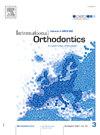Patient-reported outcome measures of accelerated upper canine retraction with low-amperage electrical stimulation: A randomized controlled trial
IF 1.9
Q2 DENTISTRY, ORAL SURGERY & MEDICINE
引用次数: 0
Abstract
Background
Interest in accelerating orthodontic tooth movement has been increasing, with a particular focus on methods that prioritize high-quality patient-reported outcomes. Among these, low-amperage electrical stimulation (LAES) emerges as a promising technique. However, the patient-reported outcome measures related to its intraoral application remain largely unexplored.
Objectives
This randomized controlled trial evaluated the clinical tolerance and patient-reported outcomes of an intraoral LAES device during maxillary canine retraction. Pain perception during the early phase (A1–A3) was designated as the primary outcome. Secondary outcomes included discomfort, swallowing, chewing, and speech difficulties, analgesic use, overall satisfaction, and willingness to recommend the procedure.
Methods and Trial design
A two-arm randomized controlled clinical trial with a 3-month follow-up. Thirty-six adults (17–28 years) with Class II Division 1 malocclusion requiring bilateral maxillary first premolar extraction were randomized to LAES (n = 18) or control (n = 18). Patient-reported outcomes were recorded at nine time points (A1–C3). Pain (primary outcome) was analysed using a linear mixed-effects model, with clinical significance defined a priori as ±20 mm on the 100-mm VAS. Equivalence was assessed using the two one-sided tests procedure with 90% confidence intervals. Secondary outcomes were summarized descriptively with between-group mean differences and 90%/95% CIs.
Results
Pain scores were lower in the LAES group at several early assessments (notably A1–A3), but between-group differences did not exceed the ±20 mm clinical threshold. Equivalence was not confirmed at A1 and A2 but was supported from A3 onward. Discomfort was greater in the LAES group during initial intervals, with confidence intervals exceeding the equivalence margin, indicating clinically relevant short-term limitations. Swallowing and chewing difficulties remained mild and clinically negligible. Speech difficulty was significantly higher in the LAES group during the first week but declined thereafter, consistent with adaptation. Analgesic intake was minimal in both groups. Despite these transient drawbacks, satisfaction was high, and all participants indicated willingness to recommend the procedure.
Harms
No systemic adverse events occurred during the trial; one patient experienced palatal abrasion that resolved without sequelae.
Conclusions
The LAES device was safe and generally well tolerated. While it did not provide clinically meaningful reductions in pain, it was associated with greater early discomfort and speech difficulty, both of which diminished with continued use. Patient satisfaction remained high, suggesting good overall acceptability. Larger, longer-term trials with device refinements to reduce palatal bulk and incorporate objective compliance monitoring are warranted before widespread clinical adoption.
Trial registration
The protocol was registered in the Clinical Trials database (NCT06875037).
采用低安培电刺激加速上犬回缩的患者报告结果:一项随机对照试验
人们对加速正畸牙齿移动的兴趣越来越大,尤其关注那些优先考虑高质量患者报告结果的方法。其中,低安培电刺激(LAES)是一种很有前途的技术。然而,患者报告的与其口腔内应用相关的结果测量在很大程度上仍未被探索。目的:本随机对照试验评估上颌犬牵出过程中口腔内LAES装置的临床耐受性和患者报告的结果。早期阶段(A1-A3)的疼痛感知被指定为主要结局。次要结局包括不适、吞咽、咀嚼和言语困难、止痛药使用、总体满意度和推荐手术的意愿。方法与试验设计:两组随机对照临床试验,随访3个月。36例(17-28岁)ⅱ类1类错颌患者需要双侧上颌第一前磨牙拔除,随机分为LAES组(n = 18)和对照组(n = 18)。在9个时间点(A1-C3)记录患者报告的结果。疼痛(主要结局)采用线性混合效应模型进行分析,临床意义先验定义为100-mm VAS±20 mm。等效性采用两个单侧检验程序,置信区间为90%。次要结局以组间平均差异和90%/95% ci进行描述性总结。结果LAES组早期评分较低(A1-A3),但组间差异不超过±20 mm临床阈值。A1和A2的等效性没有得到确认,但从A3开始得到支持。LAES组在初始时间间隔内的不适更大,置信区间超过等效范围,表明临床相关的短期局限性。吞咽和咀嚼困难仍然轻微,临床上可以忽略不计。LAES组的言语困难在第一周明显较高,但此后下降,与适应一致。两组镇痛药的摄入都很少。尽管有这些短暂的缺点,但满意度很高,所有参与者都表示愿意推荐手术。试验期间未发生全身性不良事件;1例患者出现腭磨耗,无后遗症。结论LAES装置安全、耐受性良好。虽然它没有提供临床意义上的疼痛减轻,但它与更大的早期不适和语言困难有关,这两种情况都随着持续使用而减少。患者满意度仍然很高,表明总体可接受性良好。在广泛的临床应用之前,有必要进行更大规模、更长期的试验,改进设备以减少腭体积,并纳入客观的依从性监测。试验注册该方案已在临床试验数据库(NCT06875037)中注册。
本文章由计算机程序翻译,如有差异,请以英文原文为准。
求助全文
约1分钟内获得全文
求助全文
来源期刊

International Orthodontics
DENTISTRY, ORAL SURGERY & MEDICINE-
CiteScore
2.50
自引率
13.30%
发文量
71
审稿时长
26 days
期刊介绍:
Une revue de référence dans le domaine de orthodontie et des disciplines frontières Your reference in dentofacial orthopedics International Orthodontics adresse aux orthodontistes, aux dentistes, aux stomatologistes, aux chirurgiens maxillo-faciaux et aux plasticiens de la face, ainsi quà leurs assistant(e)s. International Orthodontics is addressed to orthodontists, dentists, stomatologists, maxillofacial surgeons and facial plastic surgeons, as well as their assistants.
 求助内容:
求助内容: 应助结果提醒方式:
应助结果提醒方式:


